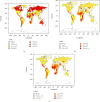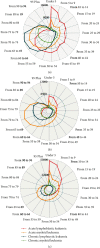The Global Burden of Leukemia and Its Attributable Factors in 204 Countries and Territories: Findings from the Global Burden of Disease 2019 Study and Projections to 2030
- PMID: 35509847
- PMCID: PMC9061017
- DOI: 10.1155/2022/1612702
The Global Burden of Leukemia and Its Attributable Factors in 204 Countries and Territories: Findings from the Global Burden of Disease 2019 Study and Projections to 2030
Abstract
Background: Leukemia is a common malignancy that has four main subtypes and is a threat to human health. Understanding the epidemiological status of leukemia and its four main subtypes globally is important for allocating appropriate resources, guiding clinical practice, and furthering scientific research.
Methods: Average annual percentage changes (AAPCs) were calculated to estimate the change trends of age-standardized rates (ASRs) from 1990 to 2019 in 204 countries and territories. The risk factors for leukemia death and disability-adjusted life-year (DALY) were also analyzed. In addition, the future trends in ASRs were projected through 2030.
Results: The total number of incident cases, deaths, and DALYs from leukemia in 2019 was 0.64, 0.33, and 11.66 million, respectively. Decreasing trends in age-standardized incidence rate (ASIR), the age-standardized death rate (ASDR), and age-standardized DALY rate were detected on a global level while increasing trends in ASIR were detected in the high-sociodemographic index (SDI) regions. The leukemia burden was heavier in males than in females. By cause, acute myeloid leukemia (AML), chronic myeloid leukemia (CML), and chronic lymphocytic leukemia (CLL) were more likely to impose a burden on the elderly, while acute lymphoblastic leukemia (ALL) showed a greater impact in the younger population. A significant positive correlation was observed between SDI and AAPC in ASIR, while SDI was negatively correlated with AAPCs in both ASDR and age-standardized DALY rate. Smoking remained the most significant risk factor associated with leukemia-related death and DALY, especially in males. Similar deaths and DALYs were caused by smoking and high body mass index (BMI) in females. Future projections through 2030 estimated that ASIR and ASDR will continue to increase, while the DALY rate is predicted to decline.
Conclusions: Patterns and trends of leukemia burden are correlated with SDI. The estimated contributions to leukemia deaths indicate that timely measures are needed to reduce smoking and obesity.
Copyright © 2022 Mengbao Du et al.
Conflict of interest statement
The authors declare they have no conflicts of interest.
Figures






References
-
- Campo E., Harris N. L., Jaffe E. S., et al. In: WHO classification of tumours of haematopoietic and lymphoid tissues . 4th. Swerdlow S. H., editor. Lyon: International Agency for Research on Cancer; 2008.
LinkOut - more resources
Full Text Sources

